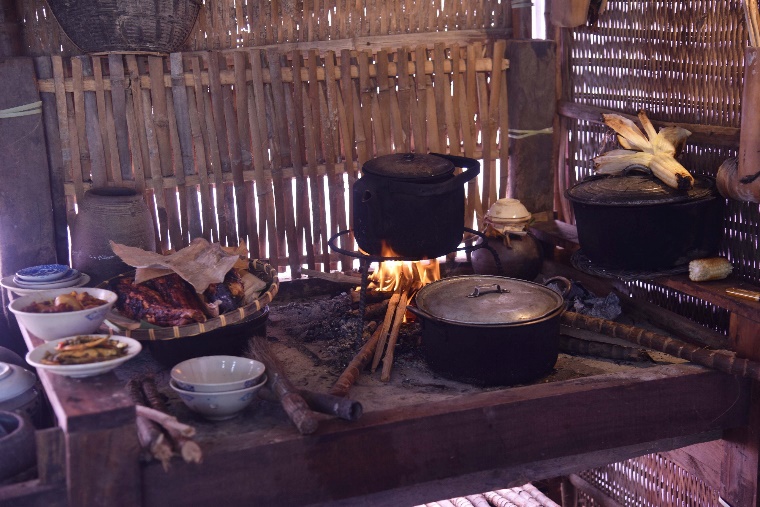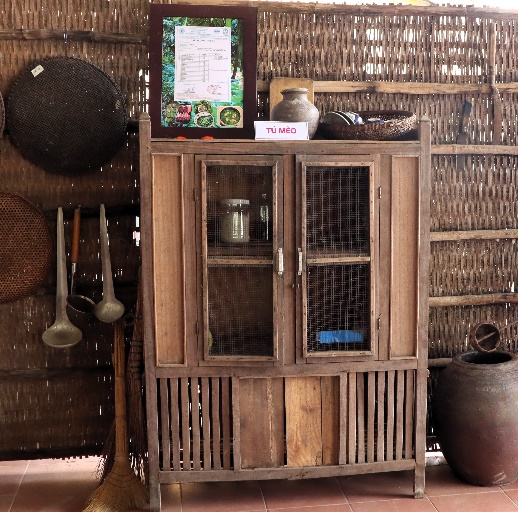Located in a stunning setting with its back against the mountains and facing the source of the Thu Bon River, Dai Binh is considered one of the most beautiful ancient villages in the mountainous area of Quang Nam Province, Vietnam.

The kitchen hearth and familiar utensils in the corner of the kitchen. Photo: TV - V.T.L
The Dai Binh Village (or Dai Buong) belongs to Que Trung Commune, Que Son District, Quang Nam Province. The village is enriched by the alluvium of the Thu Bon River, making it fertile for growing a variety of fruit trees typical of the Southern region, such as pomelo, mandarin oranges, kumquats, durian, and mangosteen. Hence, it is renowned as the "fruit garden" of the Central region. The village also cultivates strawberries used for raising silkworms, and well-known artisanal sugarcane. In addition, it harbours many unique cultural heritages that define the characteristic features of the rural landscape of Quang region.
The village still retains traces of ancient Quang cultural village with its presence of communal houses, pagodas, shrines, temples, and churches. These architectural structures are closely tied to the spiritual life of the local people. Some historical artifacts and ancient writings are also preserved, containing valuable information about the village's founding history. Within the village, there are about 3 or 4 ancient houses constructed from wood, following the simple garden house architecture typical of the Quang people. The most notable among them are a nearly 100-year-old ancient houses located near the riverbank. These houses serve different functions; one is used for worship and residence, while the other serves as a storehouse for agricultural produce.
Being a purely agricultural village, the residents here still preserve many tools and agricultural-related items used in their daily lives, farming, and hunting activities. These tools and instruments reflect the creativity of the farmers through various historical periods. Some items have high aesthetic value, such as cake molds, rice storage chests, berry-picking baskets, and wooden trays.
Particularly, the kitchen is a place where many ancient customs are preserved. The kitchen is typically organised into three tiers. The bottom tier serves as a storage for grains, tubers, and fruits and as a place for preparing meals for the family with water jars, coconut shell scoops, and various types of knives. The middle tier stores dried firewood for cooking, serving as an essential and sacred space with the presence of the Kitchen God.
The upper tier is the hearth and kitchen wall with familiar utensils, especially the bamboo pot rack used to avoid cats and dogs. Many kitchen and labour tools made from woven bamboo, such as fish steaming baskets, fish dippers, fish baskets, berry-picking baskets, trays, plates, are hung on the kitchen rack. Over time, the kitchen smoke will create a solid protective layer, helping these tools avoid damage from pests like termites.
Accompanying the kitchen is a familiar item that cannot be missed in every Quang countryside household, known as the "cat cabinet". While it may have different names in other regions, for the people of Quang, it is realistically used to store spices, food, clean dishes, and to ward off cats and dogs, affectionately known as the "cat cabinet".

"Cat cabinet" bears the cultural imprint of the Quang countryside. Photo: TV - V.T.L
Next to the kitchen is the dining table, where the entire family gathers to eat rice and chat after strenuous working hours with rustic village meals. The kitchen cannot lack a stone grinder, a very useful tool for rural mothers to prepare simple, familiar meals for the family. The grinder is used to grind beans, grind flour for making “banh xeo”, and make cakes for worshiping ancestors, especially for worshiping ancestors and praying for favourable weather and good harvests.
Located beside the kitchen house are the farming tools of agricultural farmers with the hoe, shovel, pickaxe, pole, bucket, basket, and gantry. The couple's shoulder is the means for people to carry the green vegetable bundle, the colorful flower bundle from the field home and the loaded fruit from the garden to the house, from the market to the house.
In the past, these items were very useful in daily life, but many of them are no longer in use today, inadvertently becoming museum artifacts. Some distinctive items that helped locals cope with floods, such as dugout canoes and bamboo ladders, remain useful due to the frequent and significant flood risks from the Thu Bon River. Many unique artifacts hold aesthetic and anthropological value, such as berry-picking baskets, wooden trays, ancestral altars, kitchen cabinets, tables, and wooden chairs. Particularly, relics from the wartime period, like stove grates, oil lamps, kerosene lamps, and stone mortars, are kept by some families as mementos of difficult times.
The Dai Binh Village has historically and presently been less affected by external influences, thus preserving its accumulated wealth over the years. Beyond its fruit brand, the village boasts many precious cultural heritages that can be explored and developed for tourism, making it an attractive destination.
With the diverse and abundant collection of artifacts mentioned above, establishing a Folk Life Museum in the Dai Binh Village is highly necessary and feasible. Initially, adopting a "living museum" approach to exhibit and introduce artifacts related to the lives and families of local farmers. When conditions permit in terms of expertise and artifact quantity, it is necessary to invest in the formation of a museum as a distinctive cultural venue for the Dai Binh Village to systematically display these artifacts. This will create an ideal and appealing tourist attraction, especially during fruit harvest seasons or the annual Fruit Festival in the Dai Binh Village.
Reporting by Tan Vinh - Translating by Truc Vy